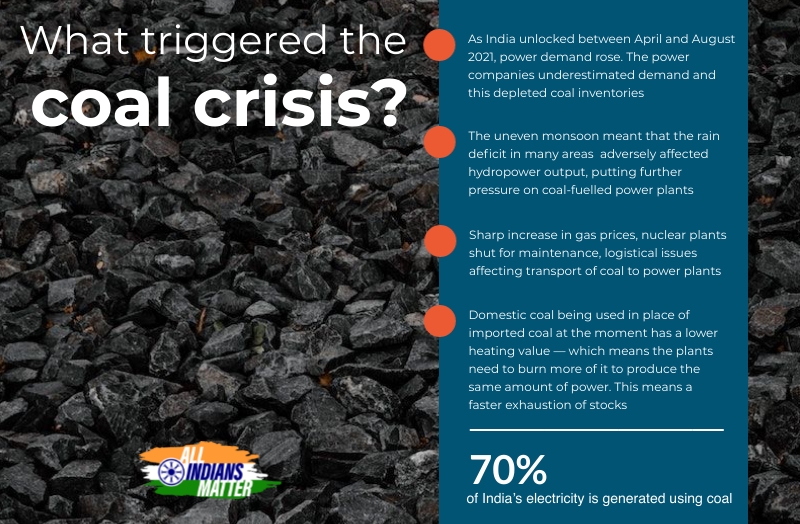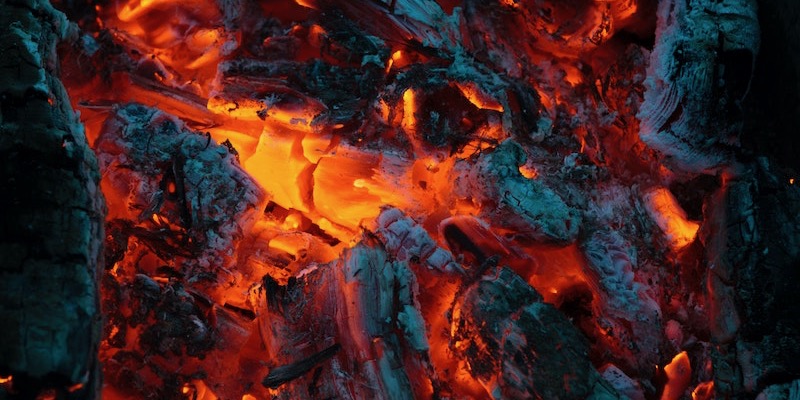Ashraf Engineer
October 16, 2021
 Episode transcript
Episode transcript
Hello and welcome to All Indians Matter. I am Ashraf Engineer.
India is facing an unprecedented coal shortage that can slow the post-COVID economic recovery, impact already-strained household budgets and dim the lights on the festive season. Roughly 70% of India’s electricity is generated using coal and its 135 coal-fired power plants have critically low levels of the mineral at a time when the economy needs it the most.
SIGNATURE TUNE
Power consumption in India has risen 17% in the past two months over the same period in 2019. This comes at a time when global coal prices are soaring, by as much as 40%, forcing a fall in India’s imports to a two-year low. This is important because our power plants are heavily dependent on coal imports.
Ironically, India has the fourth largest coal reserves in the world but is its second largest importer.
Government data showed that on October 6, 2021, 80% of our coal-powered plants had less than eight days of supplies and more than half of those had stocks worth two days or less. Normally, the plants stock an average of 18 day’s supply.
The potential power crisis could severely constrict India’s economy, which is still clawing its way back from the depths of the COVID-19 recession.
The government and state-run firms are now scrambling to avert disaster. Coal India, the public sector company responsible for 80% of India’s coal output, is in the process of ramping up supplies but this could take time. Some analysts estimate that inventories will rise to eight to 10 days’ worth of supply only by December. Until then, to use Union Power Minister RK Singh’s words, it could be “touch and go”.
How did India find itself in such a deep hole?
It’s a combination of factors. As the country unlocked between April and August 2021, power demand began to rise. The power companies, however, underestimated demand and this depleted coal inventories faster than expected.
There was also the uneven monsoon. The rain deficit in many areas adversely affected hydropower output, putting further pressure on coal-fuelled power plants.
Lastly, there was a sharp increase in gas prices, nuclear plants needed to be shut for maintenance and there were logistical issues affecting the transport of coal to power plants.
There is one more significant but little known factor: the domestic coal that is being used in place of imported coal at the moment has a lower heating value — which means the plants need to burn more of it to produce the same amount of power. Naturally, this means a faster exhaustion of stocks.
So, what can you expect next?
The power minister says that the supply crunch could last as long as six months. But, we are already into the festive season when power consumption is at its peak.
At this point, it’s difficult to imagine what the government could do. It has made reassuring noises, saying reports of the shortage are exaggerated and that things are under control. But, it could be forced to take some drastic steps – including curbs on power-intensive industries. What does this mean in practice? It involves the diversion of domestic coal supplies from industries like steel and cement to the power plants. If that happens, it would have a domino effect on national output, growth and perhaps even employment.
And how does this potential crisis affect your household budget? There is a real chance that the cost of electricity could rise. Retail inflation, especially when it comes to the cost of essentials like food, is already quite high and a rise in power bills would widen the hole in your pocket.
The situation is a wake-up call.
India badly needs to achieve a balance between soaring power demand and the need to reduce its reliance on high-polluting, coal-fed power.
The biggest obstacle to this is the scale of the change required, which makes a quick solution unlikely. As I said earlier, the major part of our energy supply comes from coal but there is no effective substitute yet.
So, the government is hoping to source coal from captive mines. Captive mines are those that produce coal only for the company that owns them. These could be aluminium plants, cement factories, etc. They don’t sell their coal to other businesses, not even state-owned ones. By turning to captive mines, the government would land up depriving the businesses that need their coal and, as I explained earlier, that has an economic fallout.
Of course, these are all short-term fixes. In the long term, India will have to invest aggressively in alternatives to coal while ensuring that they get online as quickly as possible.
When COVID-19 hit, India suffered the worst recession among the major economies. The poor handling of the power sector was the last thing it needed.
Thank you all for listening. Please visit allindiansmatter.in for more columns and audio podcasts. You can follow me on Twitter at @AshrafEngineer and @AllIndiansCount. Search for the All Indians Matter page on Facebook. On Instagram, the handle is @AllIndiansMatter. Email me at editor@www.allindiansmatter.in. Catch you again soon.






